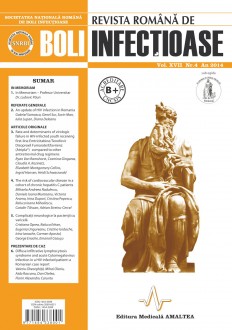SELECT ISSUE

Indexed

| |

|
|
|
| |
|
|
|

|
|
|
|
|
|
| |
|
|
HIGHLIGHTS
National Awards “Science and Research”
NEW! RJID has announced the annually National Award for "Science and Research" for the best scientific articles published throughout the year in the official journal.
Read the Recommendations for the Conduct, Reporting, Editing, and Publication of Scholarly work in Medical Journals.
The published medical research literature is a global public good. Medical journal editors have a social responsibility to promote global health by publishing, whenever possible, research that furthers health worldwide.
RATE AND DETERMINANTS OF VIROLOGIC FAILURE IN HIV-INFECTED YOUTH RECEIVING FIRST-LINE EMTRICITABINE/ TENOFOVIR DISOPROXIL FUMARATE/ EFAVIRENZ (ATRIPLA®) COMPARED TO OTHER ANTIRETROVIRAL DRUG REGIMENS
Ryan Van Ramshorst, Cosmina Gingaras, Claudia A. Kozinetz, Elizabeth Montgomery Collins, Ingrid Hansen and Heidi Schwarzwald
ABSTRACT
Objectives. The primary objective of the study was to determine whether first-line once-daily Emtricitabine/ Tenofovir disoproxil fumarate/Efavirenz (Atripla®) is associated with a lower rate of virologic failure compared with alternative first-line regimens in HIV-infected youth. The secondary objective was to identify predictors of virologic failure in the overall study sample and in the Atripla® group.
Methods. Fifty two HIV-infected youth followed at an urban HIV clinic, ages 17-25, not pregnant, with no history of prevention of mother-to-child transmission of HIV, starting their first-line antiretroviral regimen, and with at least 12 weeks of follow-up on their regimen were eligible to be included in a retrospective review of medical charts. The main outcome was virologic failure, defined as having a viral load over 400 copies/ml after 12 weeks of therapy or failure to ever reach this threshold.
Results. No significant difference in the rate of virologic failure was found between the two treatment groups. Overall, 52% of patients failed their first-line regimen. The only significant independent predictor of virologic failure was history of AIDS. Tobacco use was associated with failure in the Atripla® group. No significant difference was noted in time to failure after the start of either Atripla® or an alternative regimen. Development of resistance mutations and adherence levels did not significantly differ between the two regimen groups. However, adherence levels were significantly lower in those who failed their regimen compared to those who did not.
Conclusions. Our data do not support the hypothesis that rate of virologic failure in a simple, once-daily, first-line Atripla® regimen is lower compared to alternative regimens in our HIV-infected youth population. Adherence and psychosocial factors are important determinants of first-line regimen success and require particular consideration before offering Atripla®.
Keywords: HIV, adolescents, teens, adherence, virologic failure, treatment failure, antiretroviral therapy, HAART
